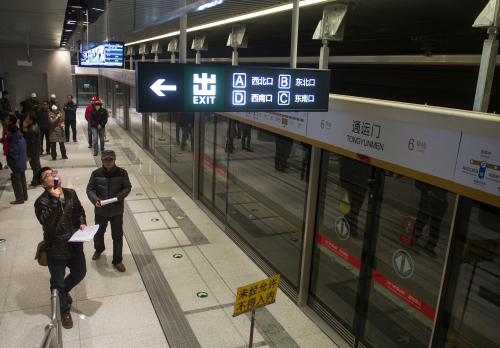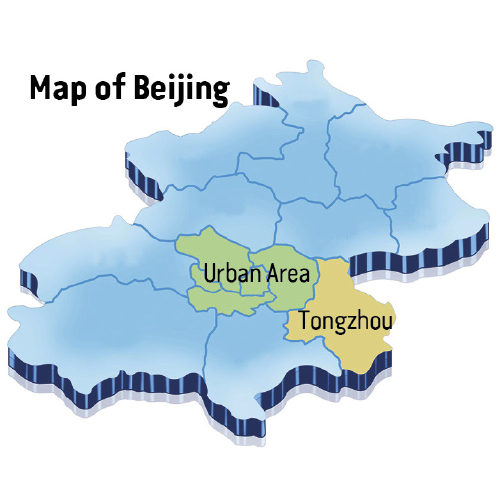 |
|
The second phase of the Beijing Subway Line 6, which links Beijing's urban area and its Tongzhou District, is put into operation on December 28, 2014 (XINHUA) |
Beijing will move some local industries and functions unrelated to its role as the country's capital to the suburbs and neighboring Hebei Province and Tianjin.
The announcement was made at a meeting of the Beijing Municipal Committee of the Communist Party of China (CPC) on July 11. The municipal leadership also approved a roadmap for developing the Tongzhou District, to the east of the downtown area, as the capital's subsidiary administrative center and promote the regional integration of Beijing, Tianjin and Hebei. Construction of the Tongzhou center is due to be completed by 2017.
"The Beijing Municipal Government offices and affiliated institutions will be shifted gradually to Tongzhou to make the city's central areas less crowded," said Huang Yan, Director of the Beijing Municipal Commission of Urban Planning.
The shift will involve the development of public transportation systems in Tongzhou, including subway and intercity railway links, as well as improved green buffer zones to separate the district from Beijing's urban sprawl, according to Huang.
"Based on the experience of developing international metropolises like Paris in France and Tokyo in Japan, building a subsidiary center can be a good solution to 'metropolitan diseases,'" Huang said.
Hu Gang, Director of the South China Urban Planning Institute of the Urban Planning Society of China, said the decision to develop Tongzhou as Beijing's subsidiary administrative center is a good beginning, allowing state-owned enterprises and public services to relocate from central Beijing and setting a good example for regional development in other areas.
According to the official website of the Tongzhou District Government, the idea of making Tongzhou a supplementary administrative district for Beijing was first mooted in 2004, but it took eight years before Beijing officially designated the district as a subsidiary administrative center.
Huang said Tongzhou set aside 55 square km of land for the project several years ago but little progress has been made.

A good start
Beijing has long strived to solve its severe "urban diseases," such as traffic congestion and air pollution. The problems have become more serious as the city's population hit 21.5 million last year, said Zhao Hong, Vice President of the Beijing Academy of Social Sciences.
"These issues are rooted in the rapid economic development of the city, an incomplete understanding of the problems and the absence of strong measures to tackle them," Zhao said.
The decision to build a new municipal subsidiary administrative center in Tongzhou, 30 km east of Tiananmen Square, is one of several moves to tackle the capital's "urban diseases," according to the integrated roadmap for the development of Beijing, Tianjin and Hebei.
The roadmap states Beijing must control its population within 23 million by 2020, with a 15 percent reduction in the number of people living within the six downtown areas. It makes a priority of relocating industries unrelated to Beijing's capital functions—its role as the capital and the national center of politics, culture, international exchanges and technical innovation.
The excessive concentration of administrative departments is a main cause of Beijing's "urban diseases" and imbalanced public service resources in different districts have also exacerbated population concentration in the urban area, said Zhang Wuming, Director of the Regional Strategy Research Center at the Beijing-based FangTang think tank.
The municipal government is housed largely in Dongcheng District. Together with Xicheng District, it is home to many government institutions, both at the central and city level, and large state-owned enterprises.
According to the roadmap, government offices performing non-capital functions together with some educational and medical institutions will be gradually moved to Tongzhou.
Zhu Erjuan, a professor with the Capital University of Economics and Business (CUEB), said the devolution of Beijing's non-capital functions is the main difficulty facing the coordinated development plan of Beijing, Tianjin and Hebei.
"A subsidiary administrative center can share functions, reducing population growth in a crowded urban area and may become a new economic growth engine," Zhu said, adding that Tongzhou will be a model for other cities across the nation.
Tang Liming, a senior researcher at public policy consulting group Anbound, believes Tongzhou is an ideal location for Beijing's subsidiary administrative center.
"Tongzhou is located between Beijing, Tianjin and Hebei, and its development will greatly facilitate the development of the whole region," Tang said.
Pang Shihui, a researcher with the Beijing Academy of Social Sciences, said the administrative departments should play a leading role during the relocation, since they are the decision-making bodies of Beijing's city restructuring plan.
Ye Tanglin, an associate professor at the CUEB, shares Pang's view. Ye believes the transfer of government offices will bring more public services and industries to Tongzhou and attract more people to live and work there.
"Massive movements of the population during workdays between suburban bedroom communities and central Beijing, which has caused serious traffic congestion during rush hour, may be avoided in Tongzhou in the future," Ye said.
Detailed studies needed
Zhang from FangTang think tank said that easing congestion in Beijing's urban area requires relocated residents to not only work in Tongzhou but also live there. "Otherwise, traffic congestion may worsen because of their daily commutes," he said.
If those workers actually move to Tongzhou, as many as 1 million people can be relocated from the city center, but such a move cannot be achieved by administrative order alone, Zhang added.
Liu Zhiyan, a researcher with the Institute for Urban and Environmental Studies at the Chinese Academy of Social Sciences, views public services as vital to the success of Tongzhou as a subsidiary administrative center.
"Only after concerns about public services, such as education and medical care, are addressed will people be willing to move out of the city center," Liu said.
At present, Tongzhou still falls short of public service in terms of the provision of hospitals and schools. "After the municipal government's move to the district, the shortages will become an urgent issue," Zhang said.
Yang Fan, 33, is a resident of Tongzhou and has little good to say about the medical services of the district. "Maybe you can't believe it, but they are always experiencing shortages in qualified doctors and nurses in the hospitals," Yang said.
She shared her experience of a hospital visit in 2012 to undergo a pregnancy test. The doctor told her it would be unwise for her to bear a child in view of her medical condition. She was shocked by the advice and sought a second opinion from the Children's Hospital in downtown Beijing, where she was told a light cold had led the doctor at the Tongzhou hospital to reach the wrong conclusion.
"It's ridiculous," Yang said. "Had I believed him, my son would have had no chance to come into the world."
She is also concerned about her 2-year-old son's education. "Next year, I will have the headache of trying to find a kindergarten for him," she said.
With a shortage of pre-school facilities in the area, Yang believes she will likely wait in long lines to secure a good place for her son.
The concerns of ordinary people have led experts believe the plans to transform Tongzhou into a subsidiary administrative center require further research.
Yu Zhongfu, a researcher at the research office of the CPC Beijing Municipal Committee, said detailed studies should be carried out before the capital relocates administrative bodies, and decisions should be made with a long-term perspective in mind.
Though Beijing faces "urban diseases," the capital still needs to conduct detailed research to determine which departments should move to Tongzhou and how much influence the subsidiary center should have, Yu added.
That view is echoed by Zhao Jian, a professor of economics at Beijing Jiaotong University. "A subsidiary administrative center has to be an integral part of Beijing's comprehensive urban planning, not a temporary scheme to accommodate some of its residents," he said.
Yu also suggests the government invite the public to participate in the decision-making process and ensure that the policies go through the legal process.
Copyedited by Kalvin Palmer
